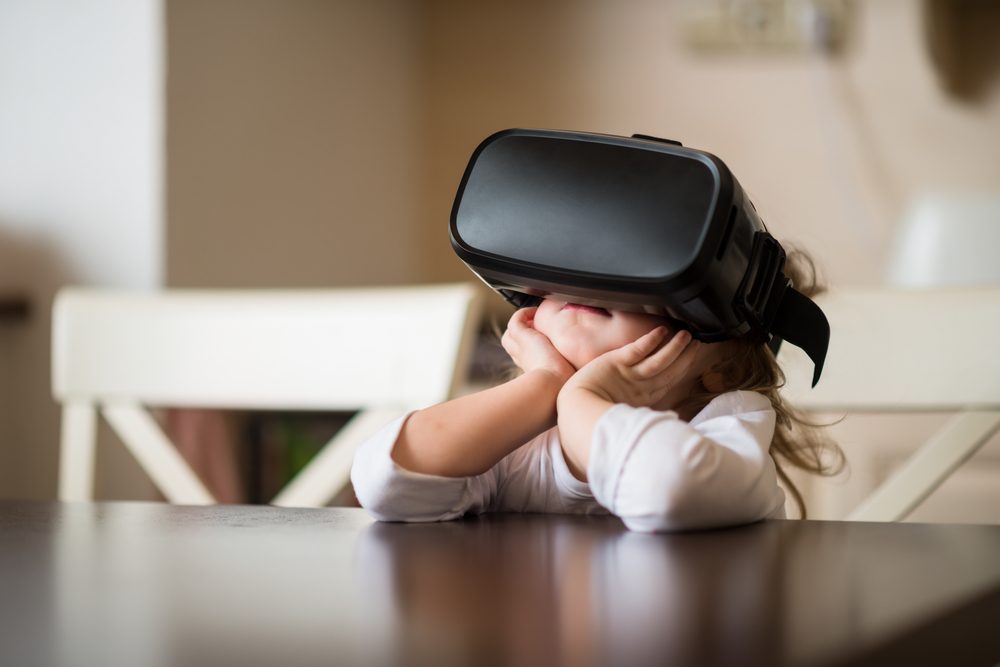Imagine sauntering through leafy French boulevards enjoying the sights and sounds of Paris in the spring, gazing in awe at the Taj Mahal on a personal guided tour,[1] or successfully scaling Everest and K2 single-handed – all from the comfort of your own living room.
These are just some of the experiences sophisticated virtual reality (VR) systems already seek to replicate, and whose developers hope could soon be delivered via the most ‘immersive’ and believable artificial sensory experiences (short of real life participation) ever created.
After years of relatively slow but steady development, recent media events, such as the release of Steven Spielberg’s VR-based adventure movie ‘Ready Player One’, have driven a surge of new interest in both virtual reality and its popular but less immersive offshoot, augmented reality (AR).[2] Low-cost viewing platforms such as Google Cardboard have also increased both the attractiveness of VR and the awareness of its potential benefits.
Going mainstream
A market that was once largely the preserve of dedicated computer gamers has increasingly moved to embrace sectors as diverse as product marketing, education and life-saving training, and we observe that it is rapidly gaining traction as a serious investment prospect.
One U.S. start-up company developing a new generation of ‘mixed reality’ viewing goggles has already attracted U.S.$1.9bn in investment from a variety of high-profile technology companies.[3] The buzz surrounding the project is so great that some researchers have even said that its innovation could ultimately be as significant as the birth of the internet or even signal “the death of reality.”[4]
At a more prosaic level, sector analyst Greenlight Insights predicts global VR revenues could reach U.S.$75bn by 2021 from just over an estimated U.S.$7bn in 2017.[5] According to analyst Orbis Research, overall global VR revenue is expected to grow at a compound annual rate of 54.84% from 2018 to 2023.[6]
Recent years have seen VR partly overshadowed by AR – as typified by its successful use in the Pokemon Go gaming craze of 2016 and its applications on social-media platforms. According to a 2017 report from specialist research provider Zion Market Research, global augmented reality market share was valued at around U.S.$3.33bn in 2015 and is expected to reach approximately U.S.$133.78bn in 2021, growing at a compound annual rate of slightly above 85.2% between 2016 and 2021.
Nevertheless, while acknowledging the relative strength of the AR proposition and forecast growth in this market, we believe the most significant developments in this field are yet to come, and are most likely to center on VR.
We think VR holds the strongest potential for really game-changing visual and sensory experiences. While the world seemed to go crazy for AR at the launch of Pokemon Go, it remains something of a halfway house which involves users without being really immersive. VR offers the potential to create deeper, more meaningful, powerful and realistic experiences.
Wide uses
We see a range of potential uses across a vast range of consumer areas, ranging from virtual tourism experiences to marketing and health care. The VR experience is already extending beyond purely a visual stimulus to embrace smell and taste. In April, a Future Tech Now exhibition in London showcased the ‘Vocktail’ – a virtual-reality cocktail that uses VR to manipulate the user’s sense of smell, touch and taste to simulate the experience of drinking a real cocktail.[7]
We think there is a very important social aspect to the development of VR which suits changing spending behaviors among younger people. Many millennials seem far keener to experience things than to buy things. They tend not to be as interested in ‘stuff’ and more interested in doing things, like traveling.
In other words, there is a new generation of people who don’t follow the same consumption patterns as their parents. As many are keen to travel and see the world on a reasonable budget, highly realistic and compelling VR-based tourism experiences – particularly if more authentic elements such as scents/smells and high-definition sounds were introduced – could become a very attractive proposition.
Technical challenges
While VR presents exciting potential, its development has not been without some technical hitches. Many have found the experience of viewing VR landscapes through headsets distinctly underwhelming, and the common ‘lag’ between the virtual world and its viewer’s movements can make some users nauseous, so while VR designers are working hard to eradicate such problems, there is still some way to go to perfect their viewing systems.
Despite this drawback, we believe VR may hold positive investment potential. While established pioneers of this market continue to refine their offering – particularly in markets such as Japan – others are also looking at this area, and we see a potentially exciting future for VR from an investment standpoint. Its interaction in other areas such as medicine and 3D printing could also have exciting potential in areas such as medical training and testing.
At an educational level, VR could also be very useful for teaching subjects such as geography, giving students access to highly realistic virtual environments they can interact with and learn more about, and it could also become a major player in new forms of retail marketing.
In the retail clothing sector, facilities such as ‘virtual changing rooms’ can now allow viewers to change their apparel through a VR viewing portal, which is just one example of a VR application that could support a much wider range of marketing initiatives in the future.
[1]Times of India. Now, take a virtual reality tour of Taj Mahal. 23 February 2018.
[2]Virtual Reality Society. Did Ready Player One Kick off the Second VR Boom? March 2018.
[3]Fortune. This Secretive Augmented Reality Firm Just Raised Another $502 Million. 18 October 2017.
[4]Rolling Stone. Magic Leap: Founder of Secretive Start-Up Unveils Mixed-Reality Goggles. 20 December 2017.
[5]Variety. Virtual reality projected to become a $7billio business this year. April 11, 2017.
[6]Reuters. Global Virtual Reality Market 2018 Growth, Projections, Potential, Size, Trends and Forecast 2023 by VR Technologies, Key Players, Applications and Services. 8 November 2017.
[7]The Telegraph. A pina colada at the touch of a button: the ‘Vocktail’ (or virtual reality cocktail) put to the test. 5 April 2018.
This is a financial promotion. ‘Newton’ and/or the “Newton Investment Management” brand refers to the following group of affiliated companies: Newton Investment Management Limited, Newton Investment Management (North America) Limited (NIMNA Ltd) and Newton Investment Management (North America) LLC (NIMNA LLC). NIMNA LLC personnel are supervised persons of NIMNA Ltd and NIMNA LLC does not provide investment advice, all of which is conducted by NIMNA Ltd. NIMNA LLC and NIMNA Ltd are the only Newton companies to offer services in the U.S. In the UK, NIMNA Ltd is authorized and regulated by the Financial Conduct Authority in the conduct of investment business and is a wholly owned subsidiary of The Bank of New York Mellon Corporation. Registered in England no. 2675952. NIMNA Ltd is registered as an investment adviser under the Investment Advisers Act of 1940. NIMNA Ltd investment business described in Form ADV, Part 1 and 2, which can be obtained from the SEC.gov website or obtained upon request. Personnel of certain of our BNY Mellon affiliates may act as: (i) registered representatives of MBSC Securities Corporation (in its capacity as a registered broker-dealer) to offer securities, (ii) officers of the Bank of New York Mellon (a New York chartered bank) to offer bank-maintained collective investment funds and (iii) associated persons of MBSC Securities Corporation (in its capacity as a registered investment adviser) to offer separately managed accounts managed by BNY Mellon Investment Management firms. Certain information contained herein is based on outside sources believed to be reliable, but their accuracy is not guaranteed. Unless you are notified to the contrary, the products and services mentioned are not insured by the FDIC (or by any governmental entity) and are not guaranteed by or obligations of The Bank of New York or any of its affiliates. The Bank of New York assumes no responsibility for the accuracy or completeness of the above data and disclaims all expressed or implied warranties in connection therewith. © 2006 The Bank of New York Company, Inc. All rights reserved.
Important information
This is a financial promotion. Issued by Newton Investment Management Limited, The Bank of New York Mellon Centre, 160 Queen Victoria Street, London, EC4V 4LA. Newton Investment Management Limited is authorized and regulated by the Financial Conduct Authority, 12 Endeavour Square, London, E20 1JN and is a subsidiary of The Bank of New York Mellon Corporation. 'Newton' and/or 'Newton Investment Management' brand refers to Newton Investment Management Limited. Newton is registered in England No. 01371973. VAT registration number GB: 577 7181 95. Newton is registered with the SEC as an investment adviser under the Investment Advisers Act of 1940. Newton's investment business is described in Form ADV, Part 1 and 2, which can be obtained from the SEC.gov website or obtained upon request. Material in this publication is for general information only. The opinions expressed in this document are those of Newton and should not be construed as investment advice or recommendations for any purchase or sale of any specific security or commodity. Certain information contained herein is based on outside sources believed to be reliable, but its accuracy is not guaranteed. You should consult your advisor to determine whether any particular investment strategy is appropriate. This material is for institutional investors only.
Personnel of certain of our BNY Mellon affiliates may act as: (i) registered representatives of BNY Mellon Securities Corporation (in its capacity as a registered broker-dealer) to offer securities, (ii) officers of the Bank of New York Mellon (a New York chartered bank) to offer bank-maintained collective investment funds, and (iii) Associated Persons of BNY Mellon Securities Corporation (in its capacity as a registered investment adviser) to offer separately managed accounts managed by BNY Mellon Investment Management firms, including Newton and (iv) representatives of Newton Americas, a Division of BNY Mellon Securities Corporation, U.S. Distributor of Newton Investment Management Limited.
Unless you are notified to the contrary, the products and services mentioned are not insured by the FDIC (or by any governmental entity) and are not guaranteed by or obligations of The Bank of New York or any of its affiliates. The Bank of New York assumes no responsibility for the accuracy or completeness of the above data and disclaims all expressed or implied warranties in connection therewith. © 2020 The Bank of New York Company, Inc. All rights reserved.





